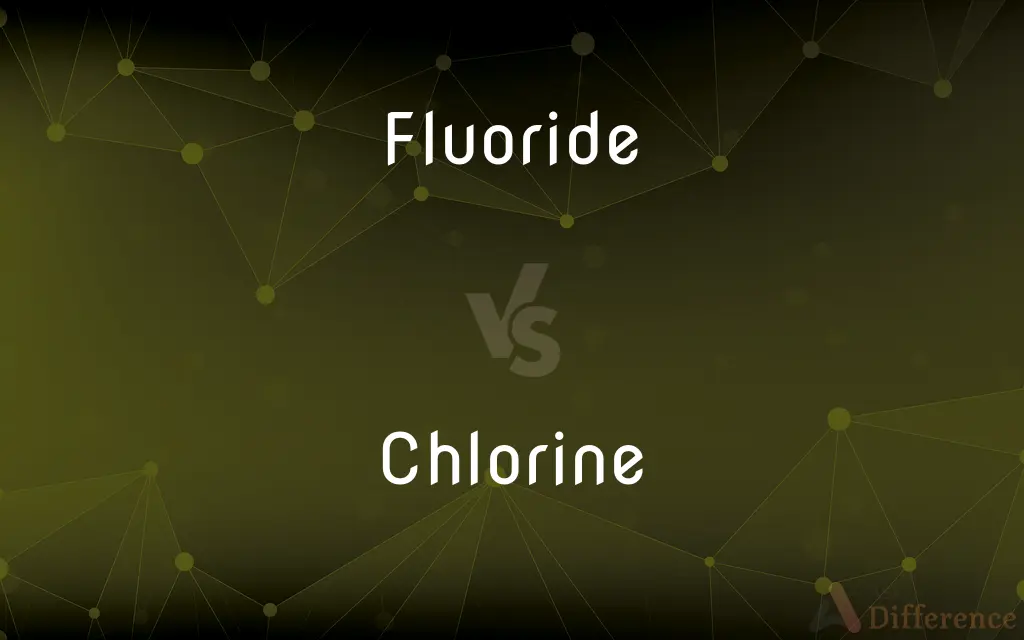Fluoride vs. Chlorine — What's the Difference?
Edited by Tayyaba Rehman — By Fiza Rafique — Updated on April 1, 2024
Fluoride is a mineral added to water for dental health benefits, while chlorine is a chemical used to disinfect water, killing bacteria and other pathogens.

Difference Between Fluoride and Chlorine
Table of Contents
ADVERTISEMENT
Key Differences
Fluoride, often added to public water supplies, helps to reduce the risk of tooth decay by making teeth more resistant to acid attacks from plaque bacteria and sugars in the mouth. In contrast, chlorine is introduced to water systems to kill harmful microorganisms, ensuring the water is safe to drink by preventing diseases like cholera and typhoid.
While fluoride's role is primarily preventive in dental health, contributing to the mineralization of bones and teeth, chlorine serves as a critical component in public health by eliminating pathogens that can cause serious illnesses. Fluoride is thus associated with long-term health maintenance, whereas chlorine addresses immediate safety concerns in water sanitation.
The introduction of fluoride into water supplies has been a matter of public health policy aimed at dental health improvement, often debated for its ethical implications regarding mass medication. On the other hand, the use of chlorine is widely accepted as a necessary step in water treatment processes, recognized for its effectiveness in making water safe for consumption.
Despite their different purposes, both fluoride and chlorine can have adverse effects when present in excessive amounts. High levels of fluoride can lead to dental fluorosis, a discoloration of the teeth, while too much chlorine can lead to water tasting and smelling unpleasant, in addition to potentially harmful health effects.
The regulation and monitoring of both fluoride and chlorine levels in water supplies are essential to balance their health benefits against possible risks. This ensures that the population receives the dental health benefits of fluoride without exceeding safe levels, and that water remains free from pathogens without the drawbacks of over-chlorination.
ADVERTISEMENT
Comparison Chart
Primary Use
Dental health improvement.
Water disinfection.
Health Benefit
Reduces tooth decay.
Kills bacteria and pathogens.
Application Method
Added to public water supplies.
Introduced to water during treatment.
Public Health Aspect
Preventive measure for dental health.
Ensures safety of drinking water.
Ethical Debates
Debated for mass medication implications.
Widely accepted for its necessity.
Potential Adverse Effects
Dental fluorosis from overexposure.
Unpleasant taste/smell, health risks if too high.
Regulation
Monitored to maintain within safe levels.
Monitored to balance effectiveness and safety.
Compare with Definitions
Fluoride
A mineral added to water to prevent tooth decay.
The city's water supply is fluoridated to promote dental health.
Chlorine
A disinfectant used in water treatment.
Chlorine is added to swimming pools to kill harmful bacteria.
Fluoride
Helps in the remineralization of teeth.
Fluoride treatments at the dentist strengthen tooth enamel.
Chlorine
Can leave a residual taste and smell.
Some people use filters to remove the chlorine taste from tap water.
Fluoride
Can cause fluorosis if too high.
Excessive fluoride in water can lead to dental fluorosis.
Chlorine
Ensures water is safe to drink.
Drinking water is chlorinated to prevent waterborne diseases.
Fluoride
Beneficial for bone and tooth health.
Adequate fluoride intake is essential for healthy teeth and bones.
Chlorine
Used in cleaning and sanitation products.
Chlorine bleach is a powerful disinfectant for household cleaning.
Fluoride
Found in toothpaste and mouthwashes.
Fluoride toothpaste is recommended for daily use.
Chlorine
Necessary for preventing disease spread.
Chlorine in water treatment has significantly reduced the incidence of diseases like cholera.
Fluoride
Fluoride () is an inorganic, monatomic anion of fluorine, with the chemical formula F− (also written [F]−), whose salts are typically white or colorless. Fluoride salts typically have distinctive bitter tastes, and are odorless.
Chlorine
Chlorine is a chemical element with the symbol Cl and atomic number 17. The second-lightest of the halogens, it appears between fluorine and bromine in the periodic table and its properties are mostly intermediate between them.
Fluoride
A compound of fluorine with another element or group, especially salt of the anion F⁻ or an organic compound with fluorine bonded to an alkyl group.
Chlorine
A highly irritating, greenish-yellow halogen element, existing as a diatomic gas, Cl2, and capable of combining with nearly all other elements, produced principally by electrolysis of sodium chloride and used widely to disinfect water, as a bleaching agent, and in the manufacture of many important compounds including chlorates, sodium hypochlorite, and chloroform. Atomic number 17; atomic weight 35.453; freezing point -100.5°C; boiling point -34.04°C; specific gravity 1.56 (-33.6°C); valence 1, 3, 5, 7. See Periodic Table.
Fluoride
Sodium fluoride or another fluorine-containing salt added to water supplies or toothpaste in order to reduce tooth decay.
Chlorine
A toxic, green, gaseous chemical element (symbol Cl) with an atomic number of 17.
Fluoride
Univalent fluorine, or a compound of fluorine, especially a binary compound of fluorine with a more electropositive element.
Chlorine
(countable) A single atom of this element.
Fluoride
(chemistry) Any salt of hydrofluoric acid; for example, potassium fluoride.
Chlorine
One of the elementary substances, commonly isolated as a greenish yellow gas, two and one half times as heavy as air, of an intensely disagreeable suffocating odor, and exceedingly poisonous. It is abundant in nature, the most important compound being common salt (Sodium chloride). It is powerful oxidizing, bleaching, and disinfecting agent. Symbol Cl. Atomic weight, 35.4.
Fluoride
(chemistry) A binary compound of fluorine and another element or radical.
Chlorine
A common nonmetallic element belonging to the halogens; best known as a heavy yellow irritating toxic gas; used to purify water and as a bleaching agent and disinfectant; occurs naturally only as a salt (as in sea water)
Fluoride
A binary compound of fluorine with another element or radical.
Fluoride
A salt of hydrofluoric acid
Common Curiosities
Is it safe to drink water with fluoride and chlorine?
Yes, when fluoride and chlorine are present within regulated safe levels, drinking water treated with these substances is considered safe and beneficial to public health.
Why is chlorine added to water?
Chlorine is added to water to kill harmful microorganisms, ensuring the water is safe to drink and free from pathogens.
Can fluoride and chlorine be harmful?
Both fluoride and chlorine can have adverse effects if present in excessive amounts; fluoride can lead to dental fluorosis, while too much chlorine can affect water's taste and smell, and potentially cause health issues.
What is the main purpose of adding fluoride to drinking water?
The main purpose of adding fluoride to drinking water is to prevent tooth decay and promote oral health in the population.
How do fluoride and chlorine differ in their health benefits?
Fluoride primarily benefits dental health by reducing tooth decay, whereas chlorine's health benefits relate to killing harmful bacteria and pathogens in water, making it safe to drink.
How does chlorine work to disinfect water?
Chlorine works to disinfect water by killing bacteria, viruses, and other microorganisms, making the water safe for human consumption.
Are there any alternatives to using chlorine for water disinfection?
Yes, alternatives to chlorine for water disinfection include ozone treatment, ultraviolet light exposure, and filtration methods, though chlorine remains the most widely used due to its effectiveness and cost-efficiency.
Is fluoridated water safe for babies and young children?
Yes, fluoridated water is safe for babies and young children in the recommended amounts, which help in the development of strong teeth. However, it's advisable to consult a pediatrician for specific recommendations.
What is the recommended level of fluoride in drinking water?
The U.S. Public Health Service recommends a fluoride concentration of 0.7 parts per million (ppm) in drinking water as optimal for preventing tooth decay while minimizing the risk of dental fluorosis.
What is fluoride used for?
Fluoride is used to strengthen teeth and prevent cavities by being added to public water supplies and dental products.
Can excessive fluoride in water be harmful?
Yes, excessive fluoride in water can be harmful, leading to conditions such as dental fluorosis (marked by changes in the appearance of tooth enamel) and skeletal fluorosis in severe cases.
How can I remove chlorine taste and smell from my drinking water?
Chlorine taste and smell can be removed from drinking water by using activated carbon filters or letting the water stand uncovered for a few hours to allow chlorine to dissipate.
How often is the safety of fluoride and chlorine in drinking water reviewed?
The safety and regulations surrounding fluoride and chlorine levels in drinking water are periodically reviewed by health and environmental agencies, such as the EPA and CDC, to ensure they remain safe and effective based on the latest scientific evidence.
Do all countries use fluoride and chlorine in their water supplies?
Not all countries use fluoride and chlorine in their water supplies; practices vary based on local health policies, water quality, and public opinion. Some countries use alternative methods for dental health promotion and water disinfection.
What should I do if I'm concerned about the fluoride or chlorine levels in my water?
If you're concerned about the fluoride or chlorine levels in your water, you can contact your local water supplier for information on current levels and treatment practices, or consider using home water testing kits.
Share Your Discovery

Previous Comparison
Bundle vs. Harness
Next Comparison
Dedicated vs. DevotedAuthor Spotlight
Written by
Fiza RafiqueFiza Rafique is a skilled content writer at AskDifference.com, where she meticulously refines and enhances written pieces. Drawing from her vast editorial expertise, Fiza ensures clarity, accuracy, and precision in every article. Passionate about language, she continually seeks to elevate the quality of content for readers worldwide.
Edited by
Tayyaba RehmanTayyaba Rehman is a distinguished writer, currently serving as a primary contributor to askdifference.com. As a researcher in semantics and etymology, Tayyaba's passion for the complexity of languages and their distinctions has found a perfect home on the platform. Tayyaba delves into the intricacies of language, distinguishing between commonly confused words and phrases, thereby providing clarity for readers worldwide.














































